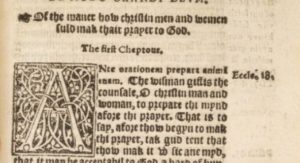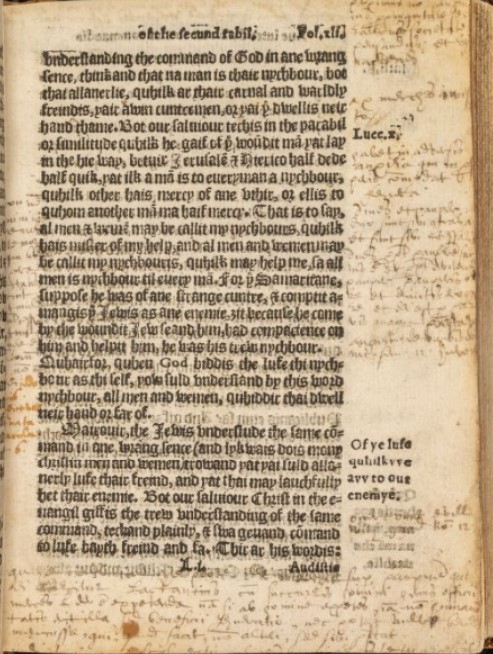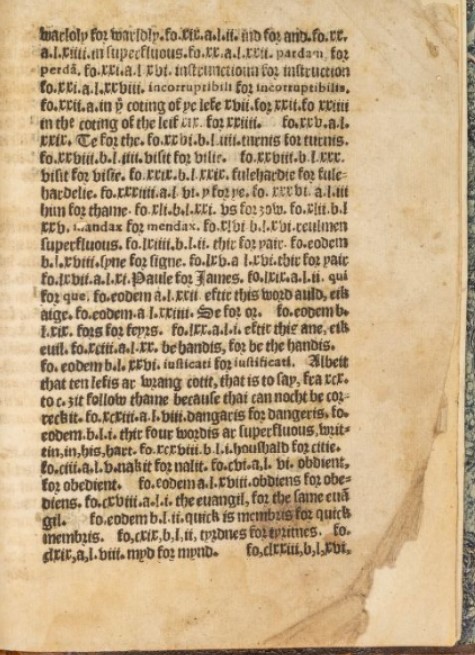Hamilton’s ‘Catechism’: A Rare Perspective on the Catholic Reform Effort
We are delighted that students on Dr Amy Blakeway’s ‘Mary Queen of Scots, France, England and Ireland’ module (MO4807) last year were again asked to submit a blog post as part of their course. So here is the first of a small number of blogs which reflect on the rare books with which the students engaged during their remote studies earlier this year.
Hamilton’s Catechism provides the modern reader with a glimpse of sixteenth century reforming Scotland that is not often considered. With the historian’s perspective, we know the reformers swept Scotland and Protestantism became the dominant religion. However, this well-known narrative means that the Catholic reformers have been scarcely acknowledged. The Catholic side of the reform story has been largely forgotten and their efforts have been misunderstood.
An informative opening page confirming Hamilton’s commission and the Catechism’s purpose. Also indicates St Andrews Library ownership with the classmark. (TypBS.B52SH leaf pi1 recto.)
In a closer analysis of the Catechism we see that John Hamilton, the Archbishop of St Andrews and fellow reforming Catholics in fact went to quite progressive lengths to renew the Church and rid it of its vices.
The Catechism: that is to say, ane commone and catholik instructioun of the christin people in materis of our catholik faith and religioun (1552) was the centrepiece of Hamilton’s program of change. His commitment to Catholic reform can be seen in the statutes passed in frequent provincial councils of the Scottish Church, and in the re-founding of St Mary’s College in St Andrews in 1553. These measures saw moderate reform within the Catholic Church focused on the quality of theological education for the proper instruction of the laity. In combination, these efforts show active commitment to reform the systemic issues of the Church and presented an effective form of renewal.
This book is indeed ‘exceedingly rare’, as is stated in the cutting from a bookseller’s catalogue attached to the front leaf of this copy.

Firstly, it was the first book printed in St Andrews and more importantly, it was printed in the vernacular. This tells us a great deal. It tells us that the author of the main text must have been fluent in Scots and, that the Scottish Catholic Church were working to ensure the correct, uniform theological education of the clergy and laity. Hamilton and his fellow Catholic Reformers, understood that the best way to equip the clergy would be to make the subject understandable and captivating to the intended audience. As well as taking the reader through the 10 Commandments, the Creed and the Sacraments, it outlines “of the maner how christin men an wemen suld mak thair prayer to God”.

This simple format is effective: it highlights the key aspects of the Bible that the laity must be aware of in their daily lives, how they can directly follow God’s divine laws and actively participate in prayer. Secondly, the Catechism includes a woodcut of the transfiguration, another step taken to engage the reader and emphasises this important moment that reveals the divinity of God to man. Together, this makes the Catechism an effective didactic aid, working toward greater understanding and wider accessibility.
This copy suggests Hamilton’s plan worked: we can deduce that it was well read throughout the centuries since its publication. There are a number of clues to suggest this: handwritten annotations by various owners, page tears due to heavy use and water marks. More so, while the seventeenth century binding is still intact, the spine had been re backed, implying heavy use. This copy has clearly been a source of interest for many readers even before the academics of the eighteenth century after it entered St Andrews University Library, and more recently, it has been made digitised and made fully accessible online.


Elizabeth Hichens
2020/21
Bibliography:
Primary:
John Hamilton, ‘The catechisme : that is to say, ane commone and catholik instructioun of the christin people in materis of our catholik faith and religioun’, (St Andrews, 1552), University of St Andrews Library’s Special Collections, TypBS.B52SH.
Secondary:
Cameron, James K., ‘The Cologne Reformation and the Church of Scotland’, The Journal of Ecclesiastical History, 3:1, (January,1979), pp.39-64.
Cameron, James K., ‘Catholic Reform in Germany and in the pre-1560 Church in Scotland’, RSCHS 20, (1979), pp.105-117.
Foggie, Janet P., John Hamilton, 1510/11-1571, Oxford Dictionary of National Biography, (23 September, 2004) < https://doi.org/10.1093/ref:odnb/12102> [Accessed 09/04/2021].
Ryrie, Alec, The Origins of the Scottish Reformation, (Manchester, 2006).